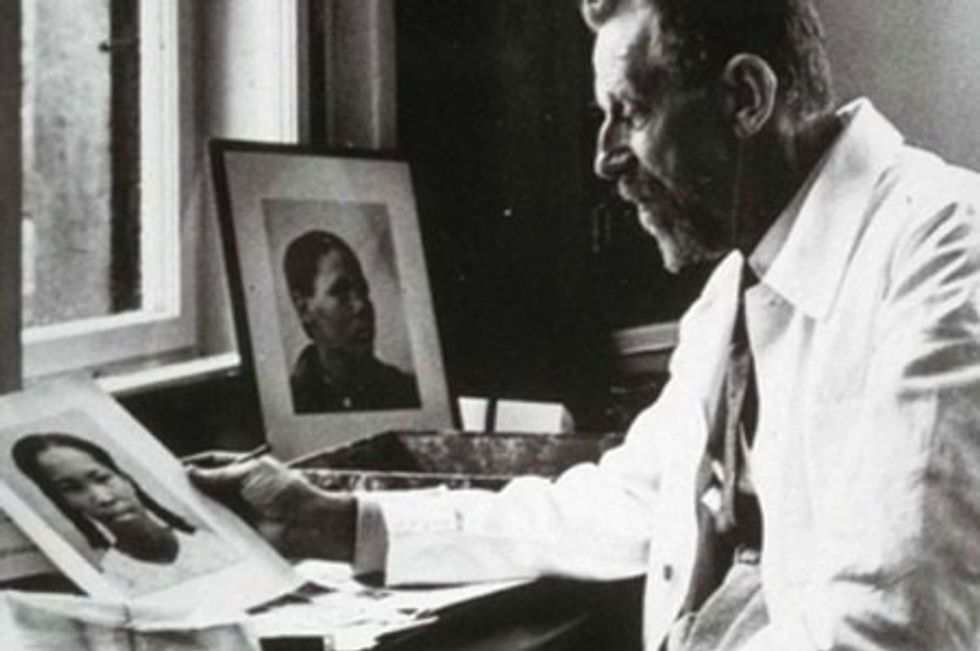It was my hope the make this article as scholarly as feasible, considering the topic. On the other hand, I cannot allow myself to disregard the gravity of genetic, epigenetic and eugenic discourse, undoubtedly when it concerns Black descendants of those formerly afflicted by chattel slavery. I am under no illusion that the topic does not involve or impinge on the social, sociopolitical and socio-economic success of my possible offspring, and those thereafter. Appropriately so, I have, and am prepared to maintain, my strongest hesitancy, and urge you all to do the same.
Dr. Rachel Yehuda, professor of psychiatry, neuroscience and director of the Traumatic Stress Studies Division at the Mount Sinai School of Medicine, has unquestionably made a name for herself. Her research on cortisol, stress responses and brain function has revolutionized the understanding and treatment of PTSD worldwide. Taking this into consideration, Dr. Yehuda initially set out to better understand phenomena occurring among second-generation holocaust survivors. In her research, she discovered that a number of the second-generation holocaust survivors did in fact have many of the same stress hormone alterations that first-generation survivors exhibited. Dr. Yehuda explains more in depth the molecular changes but, in short, has evidence to believe that the prolonged release of stress hormones – caused by environmental conditions – can and credibly do, have an affect on the genetic makeup of people who experience prolonged traumas. These hormones change the ways in which certain genes are expressed or read by the cell, and have an affect on health – being prone to certain diseases, syndromes or disorders, in addition to possibly changing mood, behavior and stress responses.
The public response to Dr. Yehuda’s findings has been nebulous at best. There are those who have prematurely welcomed the research as if it were the palliative the black community has always needed. Others have yet to join in the excitement. Among those excited about the findings is the “narrative company” Atlanta Black Star, which has recently released a video of Dr. Yehuda’s research. Of the 1 minute and 48 second video, Yehuda speaks for a mind blowing 16 seconds. Of those 16 seconds, Yehuda never directly addresses the descendants of formers slaves, never addresses the African diaspora and never even says the word black at all. From this, I can only conclude that the original material, from which these clips were taken, was in alignment with the public research of Dr. Yehuda concerning holocaust survivors. Baring this in mind, it is conceivable that – given its violent, degrading, traumatic and prolonged significance – chattel slavery has had a lasting genetic impact on the African diaspora, but we must not be so willing to submit ourselves to such a myopic and precarious hypothesis. Given the history of the world, I am inclined to tread with caution.
In 1849 Thomas Carlyle wrote an essay entitled Occasional Discourse On The Negro Question, where he addresses why slavery should have never been abolished. His stance was essentially that slavery forced work out of otherwise lazy, feeble blacks. Those who know should rule those who don’t know. Those who are educated should rule and lead the masses; those who don’t know being the masses – the blacks. His work soon influenced the rebellion of Morant Bay Jamaica in 1865. The people of Morant Bay attacked a courthouse during a demonstration. The governor general, Edward Eyre, imposed martial law where troops were ordered to go on a killing spree. In the process 1,000 homes were burned down. 439 blacks were killed in the repression, 354 executed after improper trials. Over 600 men and women, including pregnant women, were scourged with the whip, receiving up to 100 strokes. Eyre went to trial and was acquitted. How? He had a huge political and social backing that felt his actions were justified (English critic John Ruskin, priest and professor Charles Kingsley, and English writer Charles Dickens were among them). There was a plethora of ‘scientific’ evidence proving the subservience of blacks to other races.
Craniologist Samuel George Morton collected and compared skulls of different human races in the early 1800s. After his close comparison Morton came to the conclusion that the skulls were so different in shape and size that the different races may not have been of the same species. Many of the time felt that Morton’s work substantiated the racial hierarchy already set in place, with “Caucasians” at the top and Tasmanians, Native Americans and Africans at the bottom (in that order). Morton had concluded that of all the races studied; these three were not fully human. He is now regarded as a prolific writer and praised as having a profound influence on the development of physical anthropology.
Samuel Morton was not alone in his quest for justified, scientific racism. There are countless others. So many that I don’t have the time to write about them all! There was Dr. Robert Knox, a Scottish anatomist, said that different racial types were bound to struggle and that there needed to be a “war of extermination.” An abolitionist himself, he still found a way to exaggerate racial characteristics and asserted that each race possessed rigid characteristics and should never exist outside of them. He turned out to be Britain’s most sought-after anatomist and lecturer of the
Social Darwinist predicted that the “British race” would expand and work toward conquering the planet – a competition of the races. To them, evolution predicted there would be groups who simply could not compete. These would be the ones to come out on bottom or perish all together against the “superior race”. Among them were the Northern and Central American Natives, that Australian Mainlanders and the Africans. Scientists looking for exoneration and avenues for dissolving their own cognitive dissonance gave way to the eugenics movement. In 1904, Germans set foot on Namibian soil. It was no harmonious meeting by any account. The Germans, sent by modern eugenicists of the time, took the native Herero and Namaqua people and transported them to Shark Island. Kept on concentration and death camps about 3,500 people post their lives. Skulls and even severed heads of the native Herero and Namaqua people were sent to museums to be studied and put on display as a testament to the inferiority of Africans. The massacre on Shark Island was the first act of “racial cleansing” in 20th century– making it the precursor of the Holocaust.
One of the doctors to study the skulls of the murdered Namibians was Dr. Eugen Fischer. It was his aim to trace specific facial features to prove how detrimental racial mixing could be for the “Caucasian race”. Fischer felt that when racial mixing occurred, the African gene would always dominate the white gene. He was a bonafied Nazi who played a crucial role in furthering the Nazi party by conducting research and reporting his findings for the progression of the party. He ultimately aided in the sterilization of hundreds of children with French-African ancestry.
Although Dr. Yehuda may not have similar intention, there will likely be those among us, given history, who will ponder such ideas. Yehuda, a Jewish woman herself, should understand the reasoning behind my logic. This type of eugenic practice isn’t uncommon in our own country’s history. In fact, American foundations bankrolled the German eugenic development, with doctors like Eugan Fischer on the payroll. Many of these programs included schooling in “racial hygiene”, which was at the very root of the Holocaust. Many American eugenicists have identified and tracked down people who have been deemed “racially unfit” or promiscuous. For these people, what schools you can go to, where you could live and who you could and couldn’t marry was to be decided by the government. Before 1967, when the ban on interracial marriage was lifted, 27 states had passed eugenics marriage laws.
Scientists and doctors, who thought they were doing what was best for humanity, worked toward the sterilization of people deemed racially, socially and socio-economically unfit to parent. There was an unspoken sterilization movement that was comparable to the sterilizations performed by the Germans eugenicists.
Elaine Riddick, was a 13-year-old girl in 1967, when she was kidnapped and molested. She became pregnant as a result of the rape. Riddick was living with her grandmother, Maggie Woodard, when a social worker discovered her pregnancy. Grandmother Woodard was illiterate and signed an “X” on a consent form. Woodard was pressured to sign even though she could not read or write to understand the document, but she was told that if she did not sign with an “X”, Elaine would be sent to an orphanage. When Riddick went into labor she was forcibly sterilizedby the Eugenics Boardof NorthCarolina. The Eugenics board stated that Ms. Riddick was "feebleminded" and "promiscuous"; therefore, in accordance with the policies of Dr. Alan Guttmacher and Margaret Sanger, Ms. Riddick was sterilized without her consent. It is critical to note that this was not 150 years ago. It wasn't even 100 years ago. A meager 48 years separate us from the forced sterilization of Elaine Riddick. She later waged a 40 year battle for justice, winning 10million dollars for surviving victims in North Carolina.
Forced massed sterilizations were government funded and totally legal the 31 states that willfully kept grey areas. The plan was to work toward a master race by wiping out other bloodlines, including those prone to “feeblemindedness” and “promiscuity”. Things like the Human Betterment League of North Carolina existed across the nation, mainly focusing on poor communities, sterilizing people with what they called “mental illness”. The only problem being, Ms. Riddick didn’t suffer from mental illness.
My problem is not with Dr. Yehuda’s findings – after all, she wasn’t the one running around talking about black and brown people – the problem is the level of heedlessness black and brown people have shown toward it. We don’t need doctors studying our bodies like science experiments. We run the risk of being labeled genetically dysfunctional. We run the risk of being marked “in need of treatment”, where the “dark races” are unable to be civilized. Where our “laziness” and “savagery” are both unavoidable parts of our “genetic predisposition”. The possible ramification of this type of data could be significant. We run the risk of labeling large groups of people genetically inferior to those who haven’t been oppressed, and as people of color we should be skeptical of labeling our selves as such so passionately. It has never turned out well.

















 The minimum wage is not a living wage.
StableDiffusion
The minimum wage is not a living wage.
StableDiffusion
 influential nations
StableDiffusion
influential nations
StableDiffusion












